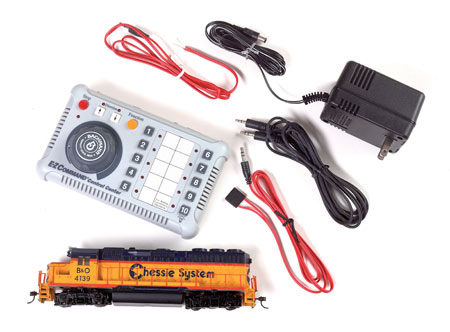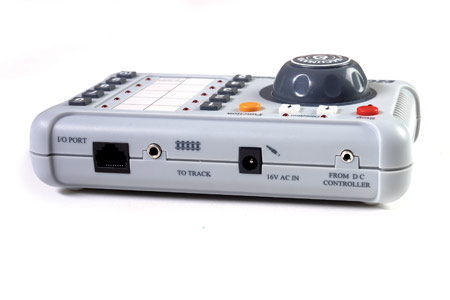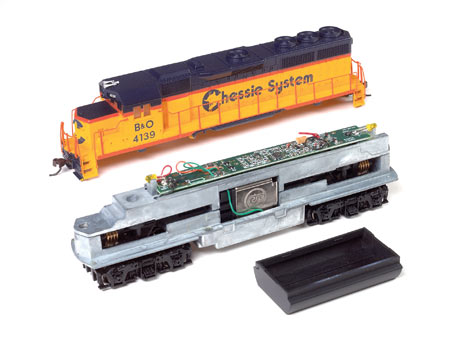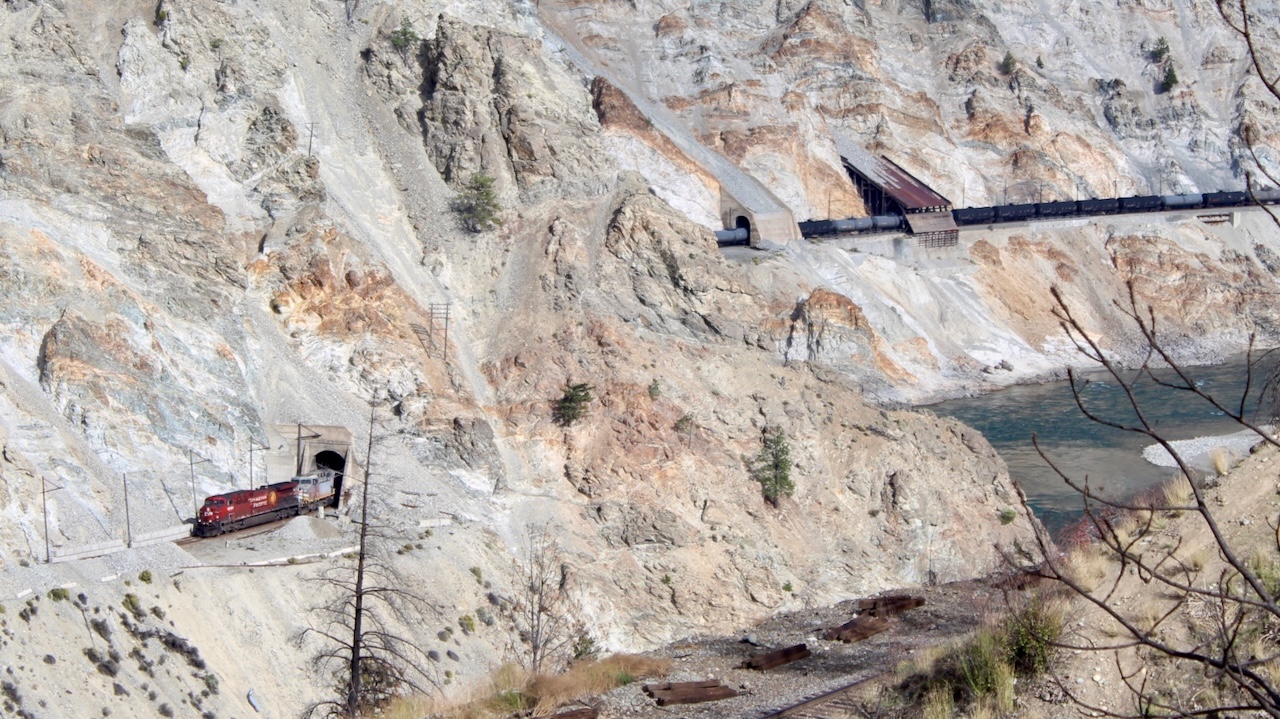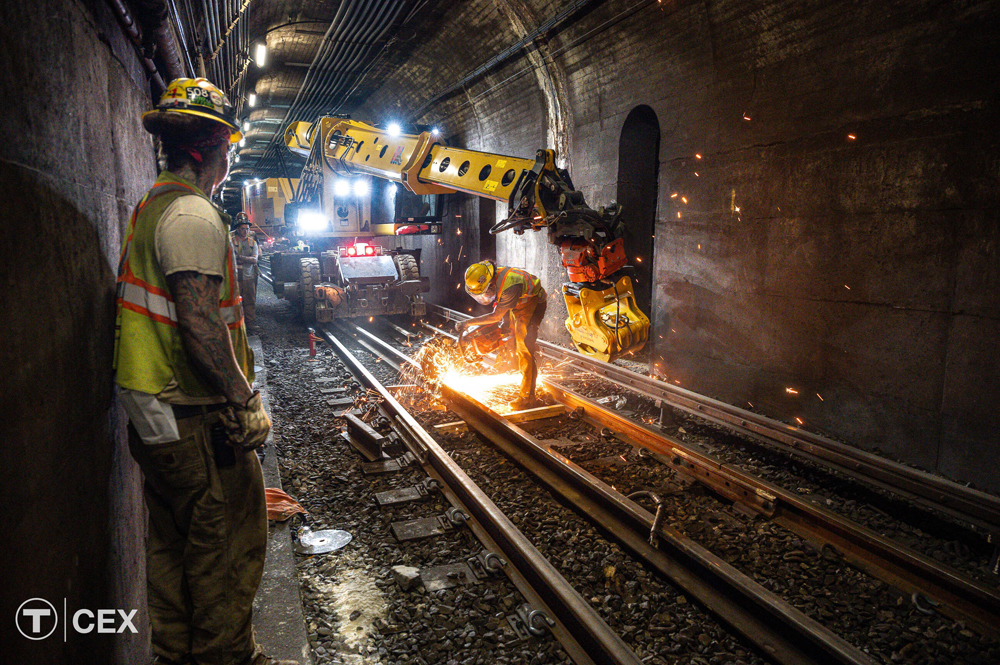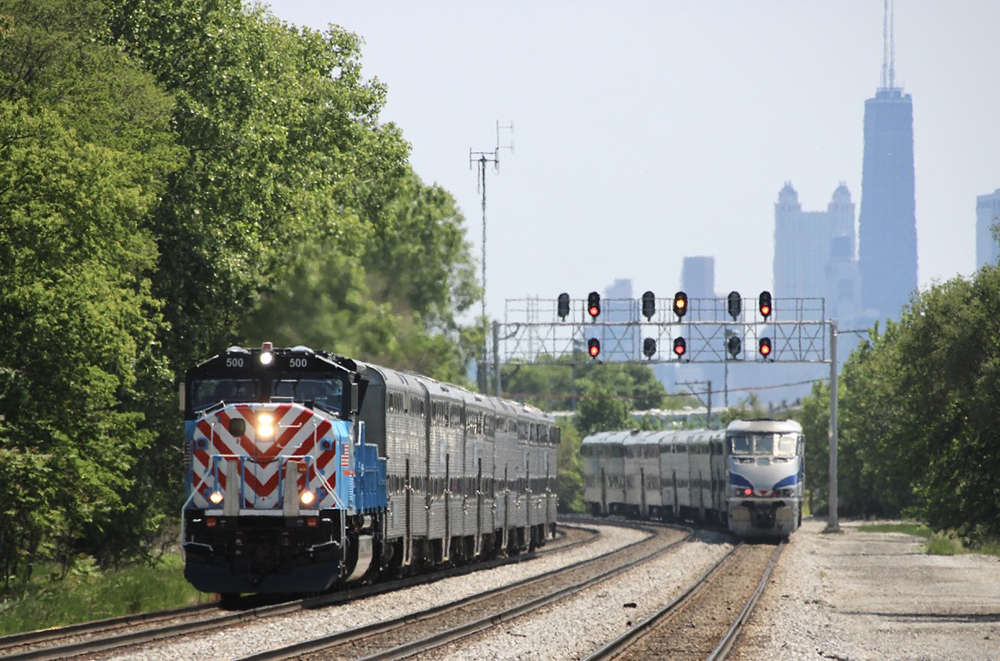The E-Z Command system is sold by itself or in sets with an HO locomotive that has a built-in DCC decoder. The initial sets are offered with a choice of an Atchison, Topeka & Santa Fe or Chessie System GP40, or a Norfolk Southern high-hood GP50. Additional road names and separate DCC-equipped HO scale FT, GP40, and GP50 diesels will be offered separately.
System components. Each E-Z Command system includes a control center, a wall-mounted 1-amp power supply, connector cables with plugs, a printed instruction booklet, and a DVD that explains and shows how it works.
The 4″ x 6-1/2″ x 2″ control center has a plastic case with labeled sockets across the back. It includes a large speed-control knob and a row of buttons marked stop, direction (lighted arrows), and function. Ten numbered buttons in two vertical rows connect preprogrammed locomotives to the throttle. Bright red light-emitting diodes (LEDs) indicate which button is activated.
An 8-page, 8-1/2″ x 11″ illustrated instruction booklet explains how to assemble and begin operation of the E-Z Command system. It takes only a couple of minutes to make the track connections and plug in its wall-mounted power supply. The LED under the stop button and one of the direction indicators light up to indicate power is on.
The E-Z Command system is sold by itself or in sets with an HO locomotive that has a built-in DCC decoder. The initial sets are offered with a choice of an Atchison, Topeka & Santa Fe or Chessie System GP40, or a Norfolk Southern high-hood GP50. Additional road names and separate DCC-equipped HO scale FT, GP40, and GP50 diesels will be offered separately.
System components. Each E-Z Command system includes a control center, a wall-mounted 1-amp power supply, connector cables with plugs, a printed instruction booklet, and a DVD that explains and shows how it works.
The 4″x 6-½” x 2″ control center has a plastic case with labeled sockets across the back. It includes a large speed-control knob and a row of buttons marked stop, direction (lighted arrows), and function. Ten numbered buttons in two vertical rows connect preprogrammed locomotives to the throttle. Bright red light-emitting diodes (LEDs) indicate which button is activated.
An 8-page, 8-½” x 11″ illustrated instruction booklet explains how to assemble and begin operation of the E-Z Command system. It takes only a couple of minutes to make the track connections and plug in its wall-mounted power supply. The LED under the stop button and one of the direction indicators light up to indicate power is on.
Basic programming is done on the main track, one locomotive at a time. Then the programmed engine must be removed from the track before you can program another locomotive. After everything is programmed, all of the locomotives can be placed on the track so operations can begin.
The instructions also explain how to add and use a separate programming track for use with consumer-installed decoders.
To operate a specific locomotive, press the appropriate address button and use the throttle knob and direction buttons as desired. While one locomotive is running, you can press another button to control a second locomotive. In theory, you could operate 10 locomotives, but two are all Bachmann recommends on the 1-amp power supply.
The system can also operate two or three low-current diesel units in a “consist” on a single address.
Other operating features. The simplified E-Z Command system doesn’t allow you to adjust configuration variables (CVs), so it has a built-in momentum feature that smooths operation. Locomotives accelerate and slow down gradually, so the engineer has to plan ahead to stop at an exact spot. It takes only a few minutes to get used to operating with the momentum.
Since this is a DCC system, the engineer has to avoid other trains. In case of an emergency, pressing the bright red stop button brings all trains to an immediate halt. While everything is stopped, adjustments can be made in any locomotive’s speed and direction settings. Once corrective action has been taken, pressing the stop button a second time resumes operation.
Pressing the command center’s function button switches the address buttons into DCC function controls to operate headlights and the sound system on an operating locomotive. A second activation of the function button returns the controls to normal. Function 10 is set for headlight controls.
The control center includes provisions to add a separate Bachmann no. 44212 power pack and controller (not included) to operate a DC locomotive. A power cable connects the power pack to the command station so one DC model can operate using address button no. 10.
Setup and testing. I connected the E-Z Command system to a loop of sectional track, plugged in two cables, and had trains running within 10 minutes. I had no problem programming the set’s locomotive to any of the button addresses. The system also correctly programmed an Atlas Master-series HO GP38, and it was easy to operate both models simultaneously.
Overall, I’m impressed with the simplicity and economy of this DCC starter system. It provides the basic advantages of NMRA standard DCC in a form that isn’t the least bit intimidating. The E-Z Command control system is a great way to get started with DCC.
Price: control system only, $95;
with decoder-equipped
GP40 or GP50 locomotive, $140.
Manufacturer:
Bachmann Industries Inc.
1400 E. Erie Ave.
Philadelphia, PA 19124
Features:
1-ampere power supply
128 speed steps
LED indicators
Meets NMRA DCC standards
Plug-and-play design
Simplified, on-track
programming
Single stationary throttle





